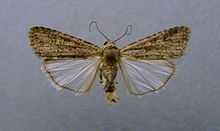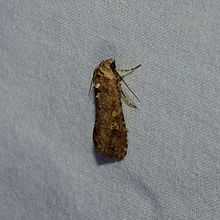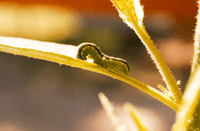Beet armyworm
| beet armyworm | |
|---|---|
 | |
 | |
| Scientific classification | |
| Kingdom: | Animalia |
| Phylum: | Arthropoda |
| Class: | Insecta |
| Order: | Lepidoptera |
| Family: | Noctuidae |
| Genus: | Spodoptera |
| Species: | S. exigua |
| Binomial name | |
| Spodoptera exigua (Hübner, 1808) | |
| Synonyms | |
| |
The Beet Armyworm or Small Mottled Willow Moth (Spodoptera exigua) is one of the best-known agricultural pest insects. It is also known as the asparagus fern caterpillar. It is native to Asia, but has been introduced worldwide and is now found almost anywhere its many host crops are grown. The voracious larvae are the main culprits. They are greenish-brown cutworms, soft and bulging caterpillars with dark longitudinal stripes. The adult is a drab brown or grey moth 2 to 3 cm in wingspan.

The larvae feed on the foliage of plants, and can completely defoliate small ones. Smaller larvae devour the parenchyma of leaves, so that all that remains is the thin epidermis and veins. Larger larvae tend to burrow holes through thick areas of plants. For example, they will burrow straight into a head of lettuce rather than neatly removing tissue from one particular leaf. This renders the produce unmarketable. They attack buds and new growth on plants, preventing flowers from opening, new leaves from sprouting, and vegetables from developing. As the smaller larvae move about they leave strands of silk behind, netting the leaves with a silvery film.
The wide host range of the beet armyworm includes asparagus, beans and peas, sugar and table beets, celery, cole crops, lettuce, potato, tomato, cotton, cereals, oilseeds, tobacco, many flowers, and a multitude of weed species. .[1] The beet armyworm does not tolerate cold. It can overwinter in warm areas, such as Florida and Hawaii, but in colder areas it dies off during the winter and the region is reinvaded by the adult moth as the weather warms and crop plants sprout.
Technical Description and variation:
- See glossary for terms used
Wingspan 26–32 mm.Forewing greyish ochreous, washed with dull yellow and sprinkled with black scales; inner and outer lines double, indistinct, filled in with pale yellowish; a dark waved median shade visible before lower half of outer line; cell dark brown; orbicular stigma pale or bright yellow, round; reniform with a curved brown lunule in centre; submarginal line pale grey; the darker shade preceding it with dark streaks between the veins; terminal spots black; hindwing semihyaline white, with the veins dark brown; all three margins shaded with fuscous.Larva pinkish brown, clotted with black; spiracular line pale ochreous, with dark upper edge.[2]
British Isles:The adult moth is known in the British Isles (where it is an introduced species and not known to breed) as the small mottled willow
References
- ↑ "Robinson, G. S., P. R. Ackery, I. J. Kitching, G. W. Beccaloni & L. M. Hernández, 2010. HOSTS - A Database of the World's Lepidopteran Hostplants. Natural History Museum, London.".
- ↑ Seitz, A. Ed., 1914 Die Großschmetterlinge der Erde, Verlag Alfred Kernen, Stuttgart Band 3: Abt. 1, Die Großschmetterlinge des palaearktischen Faunengebietes, Die palaearktischen eulenartigen Nachtfalter, 1914
External links
| Wikimedia Commons has media related to Spodoptera exigua. |
- Lepiforum
- Funet Taxonomy
- Fauna Europaea
- beet armyworm video Spodoptera exigua, a migratory plague.
- beet armyworm on the UF / IFAS Featured Creatures Web site